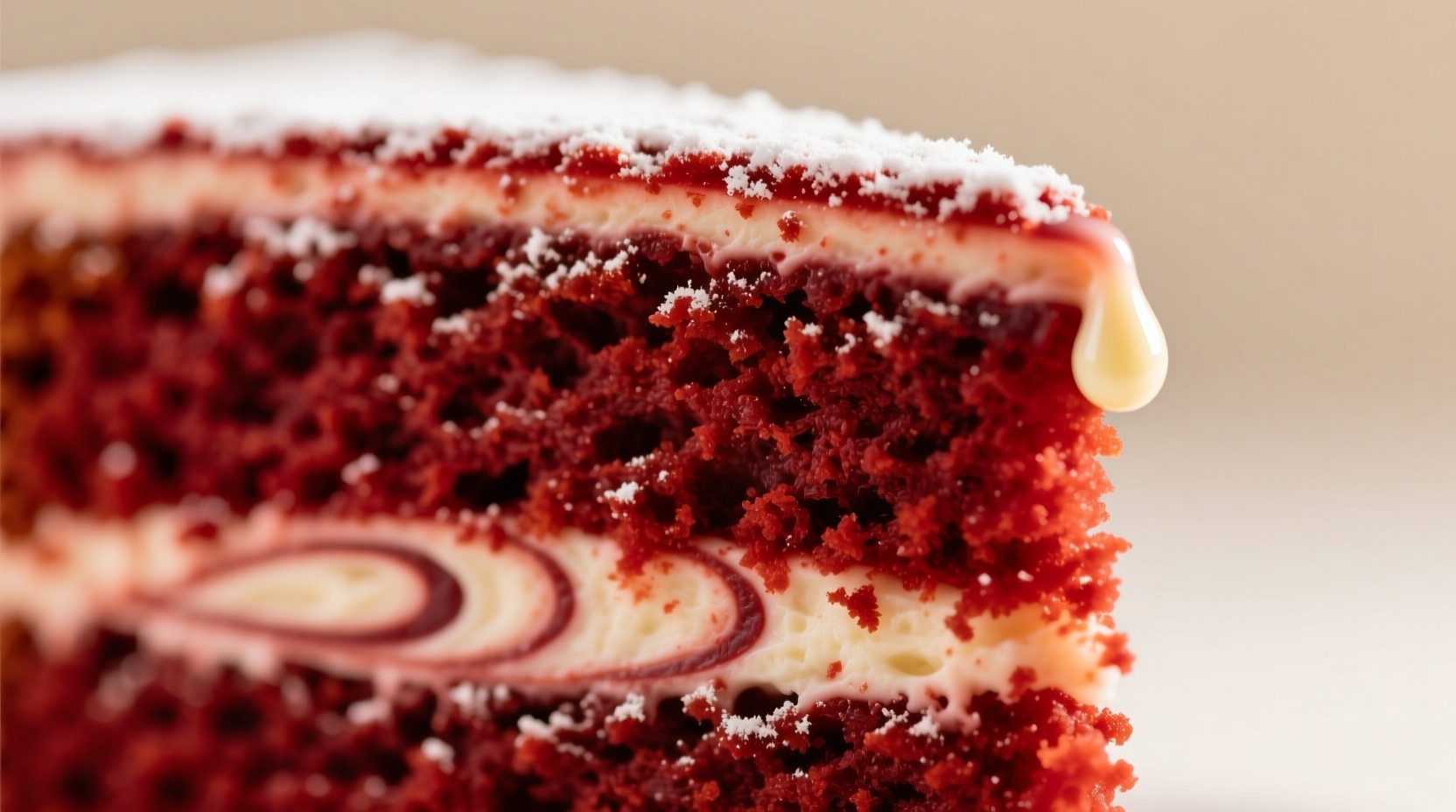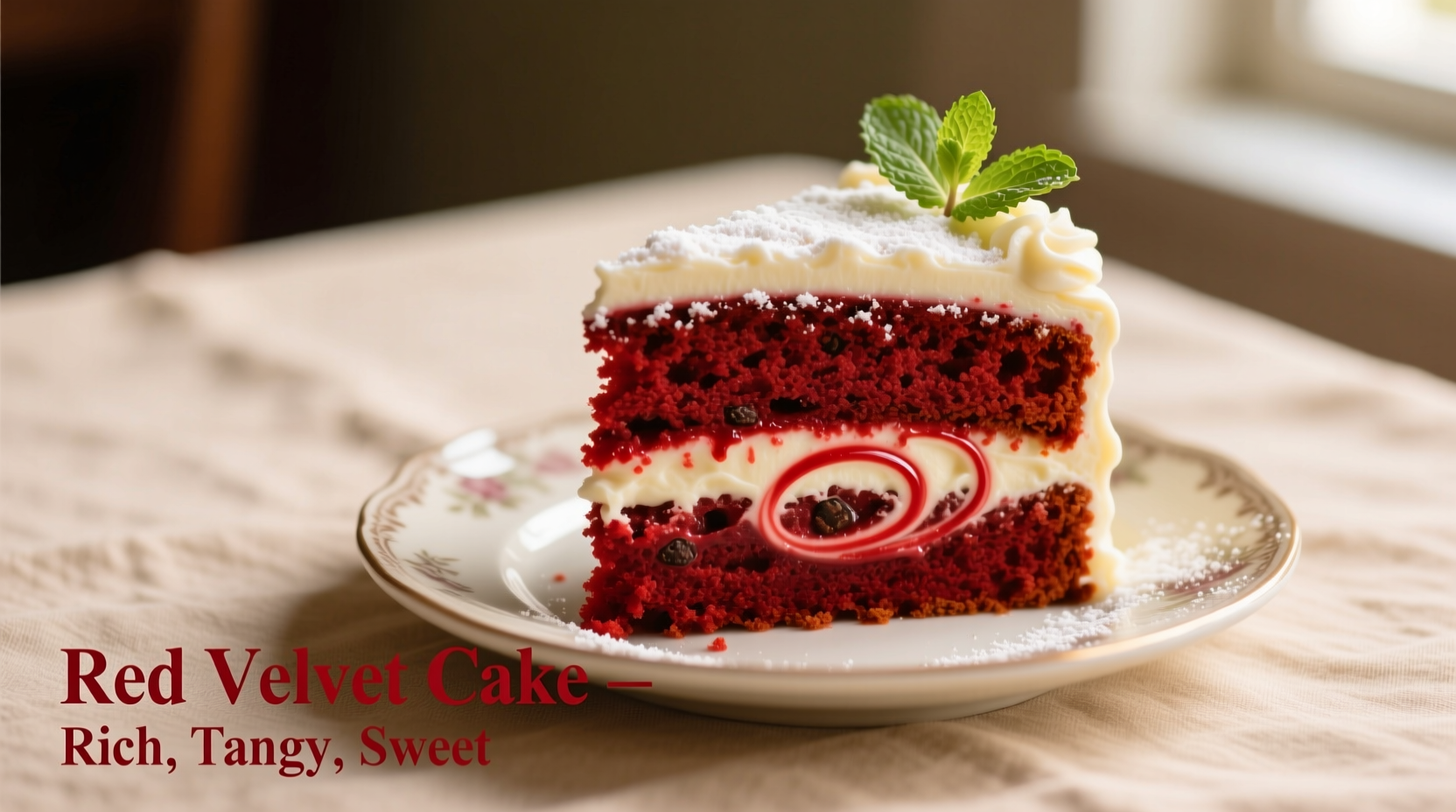The distinctive flavor of red velvet cake comes from a delicate balance of subtle cocoa, tangy buttermilk, acidic vinegar, and warm vanilla notes—not just red food coloring as many believe. This unique combination creates a mildly chocolatey yet slightly tart profile that sets it apart from traditional chocolate cakes.
When you bite into a slice of authentic red velvet cake, you're experiencing a carefully orchestrated flavor symphony that's often misunderstood. Many people mistakenly think red velvet is simply chocolate cake dyed red, but the reality is far more nuanced and scientifically interesting. Understanding these flavors isn't just culinary trivia—it's essential for bakers who want to recreate the authentic experience rather than rely on commercial mixes that mask the true profile.
The Core Flavor Components You Actually Taste
Despite its vibrant color, red velvet cake's flavor profile is surprisingly subtle and complex. Let's break down what you're actually tasting:
- Subtle cocoa notes – Not the dominant chocolate flavor of a chocolate cake, but a mild, acidic cocoa that provides depth without overwhelming sweetness
- Tangy buttermilk – Creates the characteristic slight sourness that balances the sweetness
- Vinegar acidity – Reacts with cocoa to enhance flavor complexity and create the signature texture
- Warm vanilla – Provides a supporting aromatic note that rounds out the flavor profile
- Cream cheese frosting – The tangy-sweet contrast that completes the experience (though technically not part of the cake itself)
What's notably absent is a strong "red" flavor—food coloring contributes virtually nothing to the taste. This misconception has led many to expect a flavor that doesn't actually exist in traditional recipes.

Historical Flavor Evolution: From Chemical Reaction to Cultural Icon
Red velvet cake's flavor profile wasn't deliberately designed—it emerged from a fascinating chemical reaction. Understanding this history explains why the flavor is what it is today:
| Time Period | Key Flavor Development | Ingredient Innovation |
|---|---|---|
| Early 1900s | Natural cocoa reaction with acidic ingredients created subtle reddish hue | Buttermilk and vinegar reacted with anthocyanins in natural cocoa |
| 1930s-1940s | Waldorf-Astoria popularized the "red" version with beets | Beets added moisture and enhanced natural red tones |
| Post-WWII | Modern red coloring replaced natural reactions | Artificial coloring allowed consistent bright red without flavor impact |
| 21st Century | Commercialization led to flavor confusion | Mass-market mixes added stronger chocolate flavors to meet expectations |
According to culinary historians at the Smithsonian National Museum of American History, the original red velvet flavor was primarily defined by the chemical reaction between natural (non-alkalized) cocoa and acidic ingredients like buttermilk and vinegar. This reaction not only created a subtle reddish hue but also produced a distinctive flavor profile that was neither fully chocolate nor vanilla.
Flavor Science: Why These Ingredients Create a Unique Profile
The magic of red velvet cake lies in food chemistry. When natural cocoa (which is acidic) combines with buttermilk and vinegar, several reactions occur that shape the final flavor:
- The acid-base reaction creates carbon dioxide, contributing to the cake's signature light texture
- This same reaction modifies the cocoa compounds, creating a milder, less bitter chocolate flavor
- The buttermilk's lactic acid provides a gentle tang that balances sweetness
- Vinegar enhances the perception of other flavors without being distinctly noticeable itself
Food science research published in the Journal of Sensory Studies confirms that the combination of mild acidity with subtle chocolate notes creates a flavor profile that's perceived as more complex than either component alone. This explains why properly made red velvet has a distinctive character that can't be replicated by simply adding red dye to chocolate cake.
Debunking Common Flavor Misconceptions
Several myths about red velvet cake's flavor persist. Let's clarify the reality:
| Misconception | Reality | Why It Matters |
|---|---|---|
| "Red velvet is just chocolate cake with red dye" | Traditional recipes use minimal cocoa with specific acidic ingredients | Using standard chocolate cake recipes won't recreate authentic flavor |
| "There's a special 'red velvet flavor'" | No unique flavoring exists—it's the ingredient balance that matters | Commercial "red velvet flavor" extracts alter the authentic profile |
| "The red color affects the taste" | Modern food coloring is flavorless; color doesn't equal flavor | Focus should be on ingredient ratios, not color intensity |
| "Beets are essential for authentic flavor" | Historical recipes used beets, but modern versions typically don't | Beets add moisture but aren't necessary for the core flavor profile |
According to baking experts at King Arthur Baking Company, the most common mistake home bakers make is using too much cocoa, which overwhelms the delicate balance that defines red velvet. Authentic recipes typically use just 2 tablespoons of natural cocoa per cake—barely enough to register as chocolate.
Practical Tips for Achieving Authentic Flavor
Whether you're baking from scratch or adapting a family recipe, these evidence-based tips will help you capture the true red velvet flavor profile:
- Use natural cocoa, not Dutch-processed – The acidity is crucial for both color and flavor development
- Maintain the proper acid balance – Don't reduce buttermilk or vinegar quantities without understanding their flavor role
- Don't over-sweeten – The slight tartness should balance the sweetness for complexity
- Use real vanilla extract – Its warm notes support the overall flavor without dominating
- Let flavors develop – Red velvet often tastes better the day after baking as flavors meld
Professional bakers note that regional variations exist—Southern versions often emphasize the tanginess more, while modern interpretations sometimes boost the cocoa content to meet consumer expectations shaped by commercial mixes. Understanding these differences helps you choose a recipe that matches your flavor preferences.
What Flavor Profile Works Best for Your Occasion
The ideal red velvet flavor profile depends on your serving context:
- Traditional celebrations – Stick to the authentic mild cocoa/tangy balance for historical accuracy
- Children's parties – Slightly sweeter versions with minimal tang may be preferred
- Wedding cakes – A refined balance with high-quality vanilla works best
- Gourmet presentations – Consider subtle enhancements like espresso powder to deepen complexity without altering the core profile
Remember that the cream cheese frosting plays a crucial role in the overall flavor experience. Its tangy-sweet profile should complement, not overwhelm, the cake's delicate notes. When properly balanced, the combination creates a sophisticated flavor experience that explains red velvet's enduring popularity.











 浙公网安备
33010002000092号
浙公网安备
33010002000092号 浙B2-20120091-4
浙B2-20120091-4